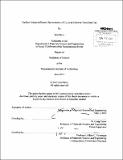Surface enhanced Raman spectrometry of C₆₀ in an electron tunneling gap
Author(s)
Perry, Erin (Erin E.), S.B. Massachusetts Institute of Technology
DownloadFull printable version (4.854Mb)
Other Contributors
Massachusetts Institute of Technology. Department of Materials Science and Engineering.
Advisor
W. Craig Carter.
Terms of use
Metadata
Show full item recordAbstract
Nanogap devices have applications in single molecule sensing and single molecule transistors. Nanogap devices comprised of a gold nanowire with a nanoscale gap containing C₆₀ were fabricated using electromigration on a silicon substrate. Raman spectra were obtained for various features of this device in order to detect the presence of C6o and study its electronic properties. The 532 nm laser source showed Raman peaks at 300,522,930-980, 1570, 1900 and 2150 cm-¹ and the 632 nm laser source showed Raman peaks at 300, 522, 930-980, 1460, and 2124 cm-¹. The device feature (gold, C₆₀, silicon or combination thereof) responsible these peaks' presence in Raman spectra was determined. There was peak broadening present at long wavelengths for gold features in the Raman spectra taken using the 532 nm laser and for spectra using the 632 nm laser when C₆₀ is present in high concentrations. This is believed to be an effect of the creation of defects in the C60 lattice due to the presence of oxygen, resulting in Frenkel excitons becoming trapped. When the Frenkel excitons recombine, they emit light causing the photoluminescence at longer wavelengths. Peak broadening was also studied in devices comprised of a gold nanoparticle substrate with C60 spun cast onto the surface. Raman spectra of nanoparticle and nanogap devices shared similar features.
Description
Thesis (S.B.)--Massachusetts Institute of Technology, Dept. of Materials Science and Engineering, 2013. Cataloged from PDF version of thesis. Includes bibliographical references (p. 31-32).
Date issued
2013Department
Massachusetts Institute of Technology. Department of Materials Science and EngineeringPublisher
Massachusetts Institute of Technology
Keywords
Materials Science and Engineering.